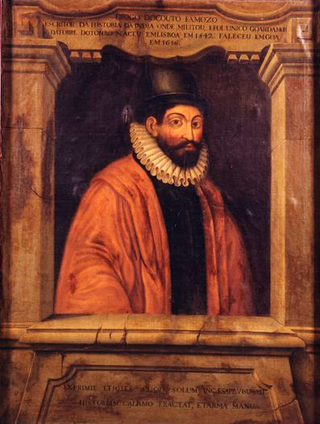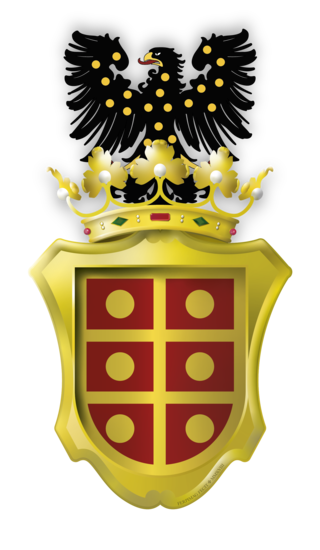Related Research Articles
Constable of Portugal was an office created by King Ferdinand I of Portugal in 1382, to substitute the High Standard-bearer (Alferes-Mor) as the head of the Portuguese Military. It was also referred as the Constable of the Kingdom.

Álvaro Vaz de Almada, 1st Count of Avranches was an illustrious Portuguese knight and nobleman, with a long and illustrious career abroad in England. He was invested by the English king, Henry VI as the 1st Count of Avranches and made a Knight of the Garter.

Duke of Lafões is a Portuguese title of nobility created under the decree of February 17, 1718, of King John V of Portugal and granted to his nephew, Dom Pedro Henrique de Bragança, the building force behind Palacio do Grilo and first son of Infante Miguel de Bragança, the latter an illegitimate son of King Peter II of Portugal and Anne Armande Pastre de Verger. Pedro's mother, Luisa Casimira de Sousa Nassau e Ligne was the first to use this title. The title was later passed on to his brother, João Carlos de Bragança e Ligne de Sousa Tavares Mascarenhas da Silva, the most famous Duke of this title.
Hugo José Jorge O'Neill was the head of the Clanaboy O'Neill dynasty, whose family has been in Portugal since the 18th century.
The Camões family were descendants of the 14th-century Portuguese nobleman Vasco Pires de Camões.

Manuel Pessanha was a 14th century Genoese merchant sailor who served as the first admiral of Portugal at the time of King Denis of Portugal. His brother was the Genoese merchant and administrator, Antonio Pessagno.

Diogo do Couto was a Portuguese historian.

Marquess of Lavradio is a Portuguese title of nobility created by Letters Patent of King José I of Portugal on 18 October 1753 for D. António de Almeida Soares de Portugal, 1st Count of Lavradio and 4th Count of Avintes.
Fernando de Castro was a 15th-century Portuguese nobleman, diplomat and military figure. Fernando de Castro was the 1st Lord of Paúl de Boquilobo. He was a member of the royal council of John I of Portugal, and governor of the household of Prince Henry the Navigator.

The Castle of Castelo Branco, is a Portuguese medieval castle in civil parish of Castelo Branco, in the municipality of the same name, in the Centro district of Castelo Branco. Known locally, as the Castelo dos Templários, the Romanesque castle was constructed under the orders of King Afonso II of Portugal in 1214.
D. Lopo de Albuquerque was made First Count of Penamacor by King Afonso V of Portugal on August 24, 1476, by which letter the Count was also given the towns of Penamacor and Abiul.

Lopo de Brito was the second Captain of Portuguese Ceylon. Brito succeeded João da Silveira and was appointed in 1518 under Manuel I of Portugal, he was Captain until 1522. He was succeeded by Fernão Gomes de Lemos.
The Captaincies of the Azores were the socio-political and administrative territorial divisions used to settle and govern the overseas lands of the Azores by the Kingdom of Portugal. These territories, a segment of the Captaincies of the Portuguese Empire, which usually conformed to the individual islands, allowing the stewardship of the King through the Donatary and Captaincy system.
References
- ↑ Quintella, p.18; Vasconcelos de Saldanha (1988); Caetano de Sousa, 1735, vol. 1, p.207. Exact date is ambiguous.
- ↑ Pereira and Rodrigues (1904: p.313-15)
- ↑ Quintella, 1839: p.19-20; Vasconcelos de Saldanha, 1988
- ↑ Caetano de Sousa, (vol. 3, p.54)
- ↑ Monumenta Henricina, vol. IV, p.211
- ↑ Baquero Moreno p.863-65; Caetano de Sousa, vol. 1 p.209; vol. 3 p.54, Vasconcelos de Saldanha (1988)
- ↑ Baquero Moreno, p.754. According to Caetano de Sousa (vol. 1, p.208), Nuno Vaz's mother, Catarina Pessanha, was the daughter of Antonio Pessanha (died Aljubarrota, 1385), the son of the admiral Lançarote Pessanha.
- ↑ Pereira & Rodrigues (p.142); Caetano de Sousa (vol.1, p.246)
- ↑ Pereira & Rodrigues, p.937. According to Caetano de Sousa (vol. 1, p.208), Lopo Vaz de Azevedo was son of Gonçalo Gomes de Azevedo, alcaide of Alenquer, and Isabel Vaz Pessanha, the sister of Nuno Vaz de Castelo-Branco and daughter of Catarina Pessanha.
- ↑ Quintella, p.32
- ↑ Quintella, p.41-42
- ↑ Pereira & Rodrigues, p.739
- ↑ João de Barros (1552–59) Décadas da Ásia: Dos feitos, que os Portuguezes fizeram no descubrimento, e conquista, dos mares, e terras do Oriente. Dec. I, Lib 6, p.24
- ↑ Viana, Mário. "O almirantado e a jurisdição sobre os homens do mar em Portugal na Idade Média" (PDF) (in Portuguese).
- ↑ Duarte, Luís Miguel. "Crimes do Mar e Justiças da Terra" (PDF) (in Portuguese).
- Baquero Moreno, H. (1980) A Batalha de Alfarrobeira: antecedentes e significado histórico, 2 vols.
- Caetano de Sousa, A. (1735–37) Historia Genealogica Da Casa Real Portugueza, 3 vols.
- "Almirante" in J.M. Esteves Pereira and G. Rodrigues, editors, (1904) Portugal; diccionario historico, chorographico, heraldico, biographico, bibliographico, numismatico e artistico Lisbon: Romano Torres. p. 313-14
- Quintella, Ignaco da Costa (1839–40) Annaes da Marinha Portugueza, 2 vols, Lisbon: Academia Real das Sciencias. vol. 1
- Severim de Faria, M. "Da Milicia Maritima e do officio de Almirante", in Noticias de Portugal ecritas por Manoel Severim de Faria Lisbon: A Gomes vol. 1, p. 139.
- Vasconcelos de Saldanha, A. (1988) "O Almirante de Portugal: estatuto quatrocentista e quinhentista de um cargo", Revista da Universidade de Coimbra, vol. 34, p. 137-56. offprint